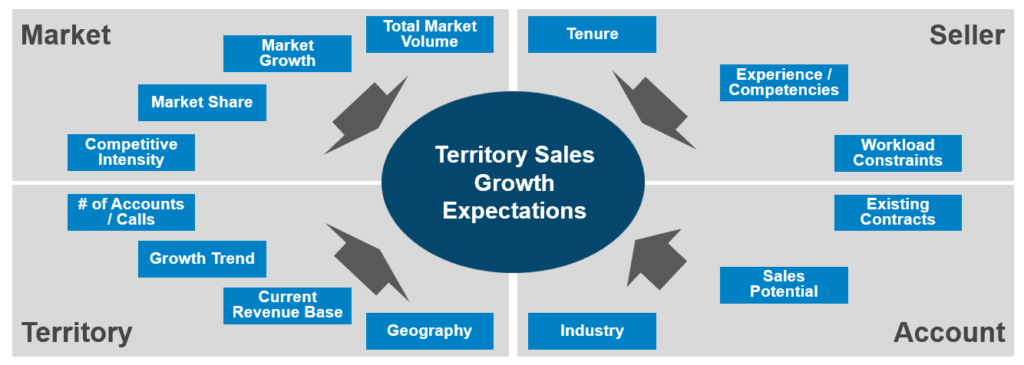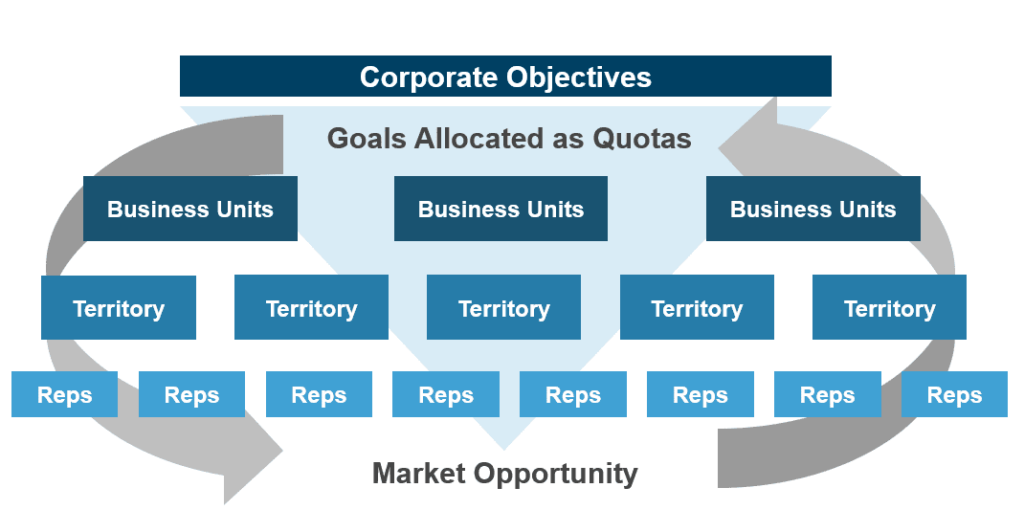Quota Concepts, Best Practices and Expected Outcomes

Quota accuracy is the primary challenge for sales compensation practitioners.
Each year, many companies ask what will work best for this round of quota allocations. As a starting point, Alexander Group recommends a sober look at last year’s attainments and the first six or nine months of 2022. This is a smart first step and serves as a good baseline of how well the company sets goal and allocates quotas–at least recently. Balanced and normal quota distributions likely require no change. However, if quota attainments are skewed or multimodal, an assessment of allocation methodology is in order.
Why Are Sales Quotas Important?
- Creates a Common Strategy. Emphasizes a common strategy and a “shared destiny” between sales personnel and field management.
- Links Sales to Business Plan. Quotas link the sales force to the overall business plan by signaling a company’s marketing direction, selling priorities and performance expectations.
- Generates Dialogue. Communication around quotas promotes dialogue between sales managers and salespeople about the most effective way to execute sales strategies.
- Motivates Sellers. Quota setting and allocation provide a direct link between performance, compensation and ongoing motivation for salespeople
- Differentiates Performers. Appropriate quotas help differentiate between high and low performers.
Quotas are set to achieve the organization’s business objectives, and Sales and Finance play important roles. What about the actual sales representatives? Field sales involvement in the quota process is indeed important, especially in cases where sales representatives have few accounts, and thus extensive knowledge about customer buying patterns. However, even as the number of accounts per salesperson increases and knowledge of specific customers decreases, the sales representative’s input is still quite useful. They provide quality forecast data. Participation in the process often boosts confidence in achieving quotas. Involving sales representatives also facilitates transparency which can further reduce angst around how the “number” is calculated. However, Alexander Group surveys indicate only about one-third of participants use sales representative-based inputs for sales quotas.
There are many different inputs that can be used to set meaningful quotas. The capability to set quality quotas depends on the level of data availability and accuracy. Thus, best practice is to invest in market and potential data to develop more accurate quotas. It is important to ensure variables used to allocate quotas are consistent with market dynamics. For example, a year over year increase in quota is not applied to products whose market size are shrinking.

Whether stated explicitly or implied, every sales organization determines the degree of difficulty of their sales objectives. The following quota setting principles are foundational to a healthy quota-based sales compensation program.
- Motivational. Quotas are fair, achievable and based on sales potential; 50-60% of incumbents should achieve their quotas.
- Aligned. Quotas align with the sales strategy and the sales compensation plan’s metrics/crediting rules.
- Consistent. A uniform process and timeline for setting sales quotas is employed across the organization.
- Transparent. The sales force understands how their quotas are set.
- Understood. Managers conduct one-on-one meetings with direct reports to explain how quotas are set and how they can achieve their goals.
- Timely. Quotas are introduced at the beginning of the performance period.
Connection between quota allocation and compensation should provide stretch goals for each Rep based on respective territory opportunity. Allocation cascades corporate objectives to the individual Sales Reps based on market opportunity.
 Misalignment between quotas and opportunities will mask true performance, inappropriately compensate and potentially demotivate sellers. It is critical to consider territory opportunity when setting quotas. Standard year-over-year increases create a discrepancy between actual and perceived performance and can leave revenue on the table. Avoid under-allocation. Quota over-allocation should be limited (typically less than 10%) and dependent on factors that reduce quota setting confidence (e.g., company size, growth rate and salesforce turnover/open territories).
Misalignment between quotas and opportunities will mask true performance, inappropriately compensate and potentially demotivate sellers. It is critical to consider territory opportunity when setting quotas. Standard year-over-year increases create a discrepancy between actual and perceived performance and can leave revenue on the table. Avoid under-allocation. Quota over-allocation should be limited (typically less than 10%) and dependent on factors that reduce quota setting confidence (e.g., company size, growth rate and salesforce turnover/open territories).
How Can You Improve Your Quota Accuracy?
Based on the insights from survey respondents, and our client work, here are five key actions to consider:
- Sales goals are established based on top-down business goals and bottom-up customer revenue opportunity.
- A uniform method of setting sales quotas is employed across the organization.
- The sales force understands how their quotas are set and receives their goals prior to the start of the performance period.
- The distribution of performance against quota is predictable with a consistent % of people over and underachieving each year
- Variables used to allocate quotas are consistent with market dynamics. For example, a year over year increase in quota is not applied to products whose market size are shrinking.
If quota is equitably distributed, quota achievement should result in a bell curve distribution with slightly more “winners” than “losers.” Quota allocation is not an exact science. There is an art to allocating quotas. Management should aim to set goals that result in a “normal” distribution, where 50-60% of individuals achieve their goal.

Contact Us
Please contact a Business Services practice lead for more information on how Alexander Group can assist you with setting quotas for your organization.